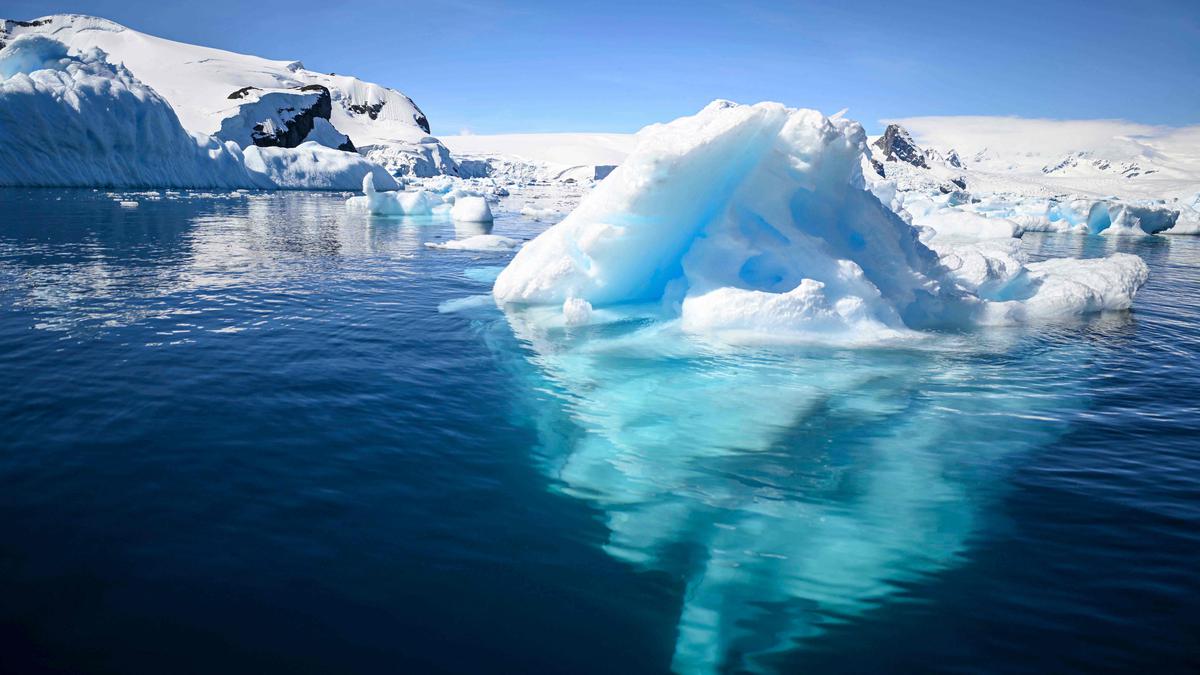- January 18, 2024
2023 recorded many of the hottest days on land and sea | Data

View of an iceberg tail at the Gerlache Strait -which separates the Palmer Archipelago from the Antarctic Peninsula, on January 15, 2024.
| Photo Credit: JUAN BARRETO
The year 2023 was the hottest on record and likely the warmest in 1,00,000 years, according to the European Union’s Copernicus Climate Change Service (C3S). Regions such as Europe, North America, and China experienced record-breaking heat.
Several factors made 2023 the warmest year on record, with escalating levels of greenhouse gases playing the biggest role. Additional factors contributing to the record included natural phenomena such as El Nino, a temporary warming in the central Pacific affecting global weather patterns, as well as other oscillations in the Arctic, Southern, and Indian Oceans.
The global average temperature in 2023 was 14.98°C, which was 0.17°C higher than the previous highest annual average in 2016. The planet was also 1.48° Celsius warmer than the pre-industrial average (1850-1900), very close to the 1.5°C mark that countries agreed not to cross in the 2015 Paris Agreement.
Chart 1 | The chart shows the monthly global surface air temperature anomalies (°C) relative to the 1991-2020 average.
Charts appear incomplete? Click to remove AMP mode
According to the global climate highlights published by C3S, each month from June to December in 2023 was warmer than the corresponding months in any previous year on record. The temperature deviation of 0.93°C recorded in September 2023, compared to the September average in 1991–2020, was the largest deviation recorded in any month in any year. Also, October, November and December 2023, each with a temperature deviation of 0.85°C above average, ranked second-largest in terms of deviations.
Chart 2 | The chart shows the number of days in a year when the temperature deviation compared to the pre-industrial average was in the following ranges: 1°C to 1.25°C, 1.25°C to 1.5°C, and 1.5°C or more.
The temperature deviation on all the days of 2023 was at least 1°C over the pre-industrial average for that day. The previous record was in 2019, which had 363 such days. In 2023, during two days, the temperature deviation was over the 2°C, the first time the 2°C mark was breached in history. Close to 50% or 173 days in 2023 were over 1.5°C warmer than the pre-industrial average. This was the case in just over 20% or 77 days in 2016, the previous warmest year on record.
Last year also witnessed record-breaking sea surface temperatures. According to C3S, each month from April to December experienced unprecedented global sea surface temperatures for the respective time of the year. August 23 and 24 of 2023 recorded the highest value of 21.02°C surpassing the previous record of 20.95°C set in March 2016. However, that record was broken on January 11 this year, with the global average sea surface temperature reaching 21.06°C, also establishing a record anomaly of 0.77°C above the 1991-2020 average.
Chart 3 | The chart plots the daily global sea surface temperature anomalies relative to the 1991-2020 average.
Chart 4 | The chart shows the daily extent of Antarctic sea ice from October 1978 to December 2023, measured in million sq. km.
In eight months of 2023, Antarctic sea ice recorded historically low extents for the corresponding periods. Both daily and monthly extents reached their all-time lows in February 2023. The average Antarctic sea ice extent in December 2023 was 9.3 million km2, a deviation of 1.7 million km2 (or 15%) below the December average for the period 1991-2020, the second-lowest extent for any December in the 45-year data available. After unprecedented low values for six consecutive months (May-October), the daily extent moved towards values closer to the 1991–2020 average around the middle of December.
Source: Copernicus Climate Change Service and Climate Reanalyzer
Also read: 2023 recap: Significant climate milestones of the year
Also watch our Data video: Watch | Data Point: Antarctica’s summer ice cover hits record low






